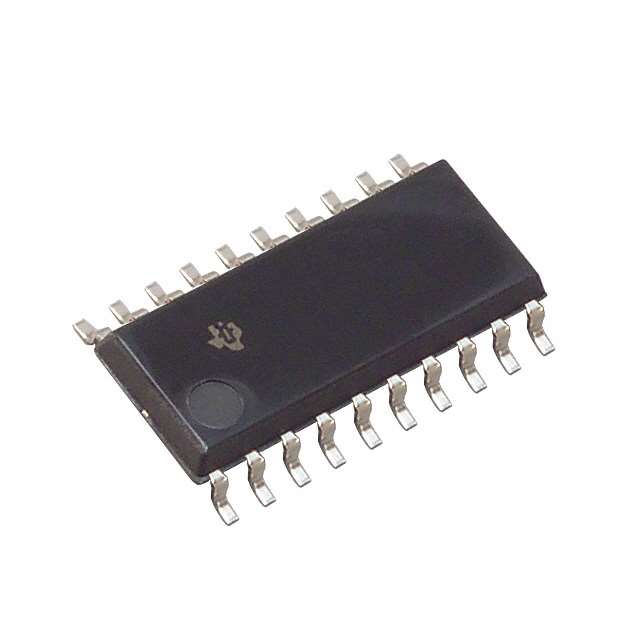Xem thông số kỹ thuật để biết chi tiết sản phẩm.

CD74HC688NSR
Product Overview
- Category: Integrated Circuit
- Use: Arithmetic Logic Unit (ALU)
- Characteristics: High-speed, CMOS logic, 8-bit magnitude comparator
- Package: SOIC-20
- Essence: The CD74HC688NSR is a high-performance integrated circuit designed for digital arithmetic and logic operations. It is commonly used in applications that require comparison of two 8-bit binary numbers.
- Packaging/Quantity: The CD74HC688NSR is available in a standard SOIC-20 package and is typically sold in reels of 2500 units.
Specifications
- Supply Voltage: 2V to 6V
- Operating Temperature Range: -40°C to +85°C
- Propagation Delay: 9 ns (typical)
- Input Current: ±1µA (maximum)
- Output Current: ±25mA (maximum)
Detailed Pin Configuration
The CD74HC688NSR has a total of 20 pins, which are assigned specific functions as follows:
- A0: Input pin for the least significant bit (LSB) of the first 8-bit number.
- A1: Input pin for the second bit of the first 8-bit number.
- A2: Input pin for the third bit of the first 8-bit number.
- A3: Input pin for the fourth bit of the first 8-bit number.
- A4: Input pin for the fifth bit of the first 8-bit number.
- A5: Input pin for the sixth bit of the first 8-bit number.
- A6: Input pin for the seventh bit of the first 8-bit number.
- A7: Input pin for the most significant bit (MSB) of the first 8-bit number.
- B0: Input pin for the LSB of the second 8-bit number.
- B1: Input pin for the second bit of the second 8-bit number.
- B2: Input pin for the third bit of the second 8-bit number.
- B3: Input pin for the fourth bit of the second 8-bit number.
- B4: Input pin for the fifth bit of the second 8-bit number.
- B5: Input pin for the sixth bit of the second 8-bit number.
- B6: Input pin for the seventh bit of the second 8-bit number.
- B7: Input pin for the MSB of the second 8-bit number.
- G: Enable pin for the comparator.
- LT: Output pin indicating that A < B.
- EQ: Output pin indicating that A = B.
- GT: Output pin indicating that A > B.
Functional Features
- High-speed operation allows for efficient comparison of two 8-bit numbers.
- CMOS logic ensures low power consumption and compatibility with a wide range of digital systems.
- The CD74HC688NSR can be cascaded to compare larger binary numbers.
- The enable pin (G) provides control over the comparator's operation, allowing for flexibility in system design.
Advantages and Disadvantages
Advantages: - High-speed operation enables quick comparison of 8-bit numbers. - Low power consumption due to CMOS technology. - Compatibility with various digital systems. - Cascadable for comparing larger binary numbers.
Disadvantages: - Limited to 8-bit comparison, not suitable for larger data sizes. - Requires external control signal (enable pin) for proper operation.
Working Principles
The CD74HC688NSR utilizes a combination of digital logic gates to compare two 8-bit binary numbers. It performs a bit-by-bit comparison, starting from the most significant bit (MSB) down to the least significant bit (LSB). The comparator generates three output signals: LT (A < B), EQ (A = B), and GT (A > B), indicating the relationship between the two input numbers.
Detailed Application Field Plans
The CD74HC688NSR is commonly used in various applications that require the comparison of two 8-bit binary numbers. Some specific application fields include:
- Microcontrollers: Used for comparing data values in microcontroller-based systems.
- Digital Signal Processing: Enables efficient comparison of digital signals in DSP algorithms.
- Data Encryption: Utilized in cryptographic systems for comparing encryption keys.
- Industrial Automation: Used in control systems for comparing sensor readings or process variables.
- Communication Systems: Enables comparison of digital data packets in communication protocols.
Detailed and Complete Alternative Models
- SN74HC688N: Similar functionality and pin configuration, but available in a DIP-20 package.
- CD74HCT688E: Compatible with TTL logic
Liệt kê 10 câu hỏi và câu trả lời thường gặp liên quan đến ứng dụng CD74HC688NSR trong giải pháp kỹ thuật
Sure! Here are 10 common questions and answers related to the application of CD74HC688NSR:
Q: What is CD74HC688NSR? A: CD74HC688NSR is a 8-bit magnitude comparator integrated circuit (IC) that compares two 8-bit binary numbers and determines their relationship.
Q: What is the operating voltage range for CD74HC688NSR? A: The operating voltage range for CD74HC688NSR is typically between 2V and 6V.
Q: How many inputs does CD74HC688NSR have? A: CD74HC688NSR has a total of 16 inputs, divided into two sets of 8 inputs each.
Q: Can CD74HC688NSR be used in both parallel and serial data applications? A: No, CD74HC688NSR is primarily designed for parallel data applications.
Q: What is the output format of CD74HC688NSR? A: CD74HC688NSR provides three outputs: A>B, A=B, and A<B, indicating the relationship between the two input numbers.
Q: What is the maximum frequency at which CD74HC688NSR can operate? A: CD74HC688NSR can typically operate at frequencies up to 25 MHz.
Q: Can CD74HC688NSR handle both positive and negative logic inputs? A: Yes, CD74HC688NSR can handle both positive and negative logic inputs.
Q: Is CD74HC688NSR suitable for battery-powered applications? A: Yes, CD74HC688NSR is suitable for battery-powered applications as it operates at low power consumption levels.
Q: Can CD74HC688NSR be cascaded to compare larger binary numbers? A: Yes, multiple CD74HC688NSR ICs can be cascaded together to compare larger binary numbers.
Q: What is the package type for CD74HC688NSR? A: CD74HC688NSR is available in a small-outline integrated circuit (SOIC) package.
Please note that these answers are general and may vary depending on the specific datasheet and manufacturer's specifications for CD74HC688NSR.

